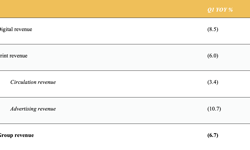Email marketing is getting harder. The unstoppable growth of social media, which has changed the way people communicate online, coupled with an increased wariness among consumers, means it has become increasingly difficult to get your messages in front of leads - especially with all of the filtering carried out by ISPs like Gmail and Hotmail - and even more difficult to get them to respond.
Most publishers follow the well-established email newsletter model: entice a visitor to your site to sign up to your 'free' ezine (as if there is any other type) and deliver regular editorial content along with marketing messages that attempt to turn them into subscribers or customers. Some titles, such as Men's Health, send out daily ezines; most do it weekly; some publishers haven't even got that far yet.
As someone who has been doing email marketing for almost a decade, I have been involved in countless debates about frequency, segmentation and the 'ad/ed' (advertising/editorial) mix. And every time we think we've cracked it, some invisible ripple goes round the world and responses and opening rates start to fall; somebody introduces a new, bigger 'report as spam' button; or a new social network introduces another new measure to monopolise web communication. It's not easy being an email marketer.
But email can still work and with direct mail dying a slow death in the corner and social media marketing failing to deliver much so far in terms of ROI, email is still the most effective way of finding subscribers and making sales. You just have to be smarter. And, fortunately, there are new tools that allow you to not only communicate with your users more timeously, but many of them take away the need for manual labour. In this article, I'm going to look at how you can use new email technology and techniques to convert more of your leads into paying subscribers.
Choosing a provider
The first step should be to find a good email service provider (ESP). There are dozens of them out there, but when choosing one, it's important to ensure they have some crucial functionality: split, or A/B, testing, the ability to segment your database by both demographics and behaviour, with no or very high limits on the number of fields in your database, and the ability to track performance and events and send triggered emails. You also need to ensure they have a team dedicated to getting your emails delivered.
Major ESPs like eCircle, Email Vision and Silverpop can do all of this. These high-end providers all have very similar functionality and, in the end, the decision may come down to support - when choosing an ESP, it's worth talking to some of their current clients to find out what the support is really like; it can vary wildly - and price. All of the ESPs are highly competitive and you need to negotiate hard on costs.
Finally, get your technical staff involved as the most painful part of the process can be integrating the ESP with your current site and systems. Your techies need to look at the API and make sure it's flexible, that the documentation is comprehensive and that there is easy access to technical support. You also need to think about how you will manage your lists and unsubscribe requests, particularly if you have a number of titles and different types of email message going out. For example, you should allow users to opt out of third party advertising emails without automatically being removed from your email newsletter list.
The welcome series
Welcome emails are the one type of autoresponder email that pretty much everyone is already using. But there is no need for a welcome email to be a solitary campaign. Leads will almost always be at their hottest when they first join your list. However, users expect the welcome email to contain some rather dull text confirming their membership (especially if the subject line reads 'Welcome to blah blah blah') and often ignore it. To make the welcome email work harder, you should include a great offer along with a few warm words from your editor, or give them a gift and a reason to start looking forward to getting your messages.
The welcome email can be followed up by a series of emails. This is your chance to ensure your hot new leads get the strongest copy while they are fresh. The series should follow the same pattern as the emails they will receive later (eg, an ezine on Monday and a marketing or solus email on Thursday). Send your strongest copy first, second strongest second, and so on. This is your best chance to convert your leads. The temptation might be to treat them softly at first, to win them over before going in for the kill. You need to test to pitch it right but in my experience, it's better to front-load your series with strong offers.
To make your autoresponders work even better, try segmenting the list based either on their demographics or source. For example, you might have different email series split by gender or interests or even the topic they searched for when they came to your site. Ideally, this segmentation should continue for the duration of their life with you.
Going to hospital
With your welcome series doing the hard work of converting new leads, you should next turn your attention to your strongest prospects, your lapsed subscribers, and set up a 'hospital' series. It's vital to try to rescue lapsed subs as quickly as possible, and automated emails can do this for you. If you have an online subscription, it should be possible to integrate your ESP with your site so that as soon as someone's subscription is cancelled or ends, you can trigger an email, or series of emails, enticing them back with strong offers. At the very least, you should email them a survey to find out why they cancelled. Some ESPs offer integrated survey tools; otherwise you can use something free like Survey Monkey or Google Forms.
You don't even need to wait until they are lapsed. Automated emails can and should be used to communicate with subscribers throughout their lifecycle. For example, if they are on a cheap or free trial, you can send them a gift just before the point where the trial ends, or the promise of a gift to come after their renewal date. Similar offers and freebies can be sent out around each renewal point. Your ESP should allow you to split test this, especially if you are worried that too much communication will prompt cancellations.
Best behaviour
If you want to be properly sophisticated, you need to start responding to your leads' behaviour and using your email system to find out more about them and responding accordingly.
For example, you can alter the frequency with which you send emails depending on how responsive they are. People who never open your emails should be segregated before they mark you as spam and emailed very occasionally to try to reactivate them. Those who love receiving your emails can get more! Some businesses use preference centres to ask recipients how often they want to receive messages.
You can also segment users depending on what they open and click. For example, some ESPs allow you to categorise or tag links in your emails; you can then target anyone who regularly clicks on links about a particular topic because you know that's what they are interested in.
Or you can trigger emails based around someone clicking on a special one-off link, eg 'Click here to learn more about this new product', which triggers an email, or sequence of emails about the new product. At Electric Word, we used this technique very effectively in 'warm-up' campaigns, where we offered a special discount to anyone who clicked on the link to find out more, then whipped them into a frenzy of anticipation by emailing them a series of messages leading up to the launch. We even had people phoning us on the morning of the launch asking when they would receive the sales email.
An increasing number of sites have started to trigger emails based on on-site behaviour. The basket abandonment email is the most common, where a short message is sent to anyone who put an item in their cart but didn't checkout. This technique can be used for any on-site processes where the user drops out, such as the registration process (as long as you get their email address first!) or an enquiry form.
Finally, no article about email marketing should neglect the importance of A/B testing. All of the above techniques and ideas should be A/B tested, either through splitting your list and treating them differently, or campaign by campaign. You can even use multivariate testing if you have a sophisticated system and enough traffic / activity to make it worthwhile.
The days of being able to simply build a big list and hit it with manually crafted emails are behind us. But by adopting some clever but simple techniques, email can be a more powerful tool than ever, especially if you integrate it well with your website and databases. With the rise in social media, email's days may be numbered in the long term - but there is still a great opportunity to make it work for you.










